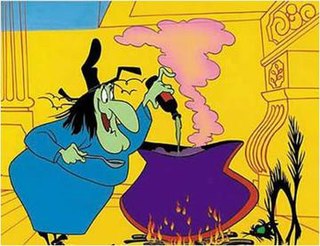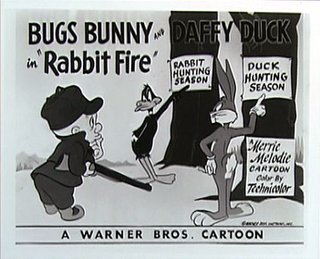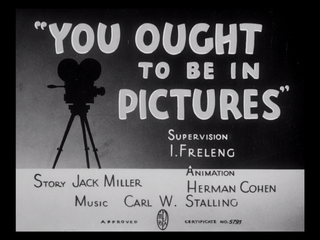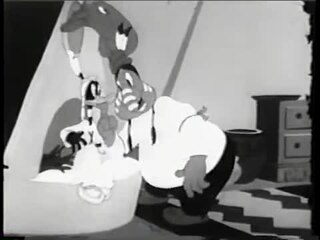
Looney Tunes is an American animated franchise produced and distributed by Warner Bros. It began as a series of short films that originally ran from 1930 to 1969, concurrently with its partner series Merrie Melodies, during the golden age of American animation. Following a revival in the late 1970s, new shorts were released as recently as 2014. The two series introduced a large cast of characters, including Bugs Bunny, Daffy Duck, and Porky Pig. The term Looney Tunes has since been expanded to also refer to the characters themselves.

Daffy Duck is a fictional character created by animators Tex Avery and Bob Clampett for Leon Schlesinger Productions. Styled as an anthropomorphic black duck, he has appeared in cartoon series such as Looney Tunes and Merrie Melodies, in which he is usually depicted as a foil for either Bugs Bunny, Porky Pig or Speedy Gonzales. He was one of the first of the new "screwball" characters that emerged in the late 1930s to replace traditional everyman characters who were more popular earlier in the decade, such as Mickey Mouse, Porky Pig, and Popeye.

Sylvester J. Pussycat Sr. is a fictional character, an anthropomorphic cat in the Looney Tunes and Merrie Melodies series of cartoons. Most of his appearances have him often chasing Tweety Bird, Speedy Gonzales, or Hippety Hopper. He appeared in 103 cartoons in the golden age of American animation, lagging only behind superstars Bugs Bunny, Porky Pig, and Daffy Duck. Three of his cartoons won Academy Awards, the most for any starring a Looney Tunes character: they are Tweetie Pie, Speedy Gonzales, and Birds Anonymous.

Merrie Melodies is an American animated comedy short film series distributed by Warner Bros. Pictures. It is the companion series to Looney Tunes, and featured many of the same characters as the former series. It originally ran from August 2, 1931, to September 20, 1969, during the golden age of American animation, though it had been revived in 1979, with new shorts sporadically released until June 13, 1997. Originally, Merrie Melodies placed emphasis on one-shot color films in comparison to the black and white Looney Tunes films. After Bugs Bunny became the breakout character of Merrie Melodies and Looney Tunes transitioned to color production in the early 1940s, the two series gradually lost their distinctions and shorts were assigned to each series randomly.

Witch Hazel is an animated cartoon character in the Warner Bros. Looney Tunes and Merrie Melodies series of cartoons and TV shows. Witch Hazel is a fairy tale witch antagonist with green skin, a round figure, bulbous facial features, and a single tooth. The name is a pun on the witch-hazel plant and folk remedies based on it.
Spike the Bulldog and Chester the Terrier are animated cartoon characters in the Warner Bros. Looney Tunes and Merrie Melodies series of cartoons. Spike is a burly, gray bulldog wearing a red sweater, a brown bowler hat, and a perpetual scowl. Chester is a Jack Russell terrier who is just the opposite, small and jumpy with yellow fur and brown, perky ears.

Rabbit Fire is a 1951 Looney Tunes cartoon starring Bugs Bunny, Daffy Duck, and Elmer Fudd. Directed by Chuck Jones and written by Michael Maltese, the cartoon is the first in Jones' "hunting trilogy"—the other two cartoons following it being Rabbit Seasoning and Duck! Rabbit, Duck! It is also the first cartoon to feature a feud between Bugs and Daffy. Produced by Edward Selzer for Warner Bros. Cartoons, Inc., the short was released to theaters on May 19, 1951 by Warner Bros. Pictures and is often considered among Jones' best and most important films.

Daffy Duck's Quackbusters is a 1988 animated compilation film featuring classic Warner Bros. Cartoons shorts and animated bridging sequences, starring Daffy Duck. The film was released to theaters by Warner Bros. on September 24, 1988. It was the final theatrical production in which Mel Blanc provided the voices of the various Looney Tunes characters before his death in July 1989.

You Ought to Be in Pictures is a 1940 Warner Bros. Looney Tunes short film directed by Friz Freleng. The cartoon was released on May 18, 1940, and stars Porky Pig and Daffy Duck.

Deduce, You Say is a 1956 Warner Bros. Looney Tunes cartoon, directed by Chuck Jones and written by Michael Maltese. The short was released on September 29, 1956, and stars Daffy Duck and Porky Pig. The title is a play on the exclamation, "The deuce, you say!"

Conrad the Sailor is a 1942 Warner Bros. Merrie Melodies cartoon supervised by Chuck Jones. The title character, Conrad the Cat, is voiced by Pinto Colvig and animated by the quintet. The other featured player is Daffy Duck, voiced as usual by Mel Blanc.

Scrap Happy Daffy is a 1943 Warner Bros. Looney Tunes short directed by Frank Tashlin. The cartoon was released on August 21, 1943, and stars Daffy Duck.
Bugs Bunny's Howl-oween Special is a Looney Tunes animated Halloween television special directed by David Detiege, which first aired on CBS on October 26, 1977.

The Stupor Salesman is a Warner Bros. Looney Tunes cartoon, directed by Arthur Davis, and written by Lloyd Turner and Bill Scott. The cartoon was released on November 20, 1948, and stars Daffy Duck.

The Daffy Duckaroo is a Warner Bros. Looney Tunes cartoon directed by Norman McCabe. The cartoon was released on October 24, 1942, and stars Daffy Duck. The film is set in the American West, and Daffy plays a singing cowboy.
Along Came Daffy is a 1947 Warner Bros. Looney Tunes cartoon directed by Friz Freleng and written by Michael Maltese and Tedd Pierce. The cartoon was released on June 14, 1947, and stars Daffy Duck and Yosemite Sam.
Nasty Quacks is a 1945 Warner Bros. Merrie Melodies cartoon directed by Frank Tashlin. The cartoon was released on December 1, 1945, and stars Daffy Duck.
Daffy Duck and Porky Pig Meet the Groovie Goolies is a 1972 animated one-hour TV-movie that was aired on December 16 as an episode of the anthology series The ABC Saturday Superstar Movie. In this Filmation-produced movie, Daffy Duck, Porky Pig, and other Looney Tunes characters interact with the characters from the Filmation series Groovie Goolies.
A-Haunting We Will Go is a 1966 Warner Bros. Looney Tunes cartoon directed by Robert McKimson. The short was released on April 16, 1966, and stars Daffy Duck, Speedy Gonzales and Witch Hazel. As with the other Witch Hazel cartoons, June Foray voices Witch Hazel while Mel Blanc voices Speedy Gonzales, Daffy Duck, and Daffy's nephew.
Wise Quackers is a 1949 Warner Bros. Looney Tunes cartoon directed by Friz Freleng. The film was released on January 1, 1949, and stars Daffy Duck and Elmer Fudd.













